Want to learn guitar but can’t find a teacher? Learning guitar independently can be challenging at first. Most people can learn basic guitar skills in just 30 days with a structured plan and daily practice.
I’ll show you how to learn guitar independently using free online tools, simple chord patterns, and effective practice methods that work. Ready to start learning guitar?
Key Takeaways
You can learn basic guitar skills in 30 days by practicing just 15–30 minutes daily with proper tools and methods.
Start with four basic chords (E minor, G major, C major, D major) that will let you play hundreds of popular songs right away.
Free resources like JustinGuitar on YouTube and apps like Yousician can speed up learning by 40%, according to Unfinished Man website.
Practice with a mix of basic chord progressions, simple strumming patterns at 60 beats per minute, and ear training exercises.
Recording yourself playing and keeping a practice diary helps track progress and spot areas needing improvement over the 30-day period.
Table of Contents
Start With the Basics

You’ll need to know your guitar inside and out before you start playing songs. A good grasp of basic guitar parts and proper posture will make your learning path much smoother.
Learn the parts of a guitar
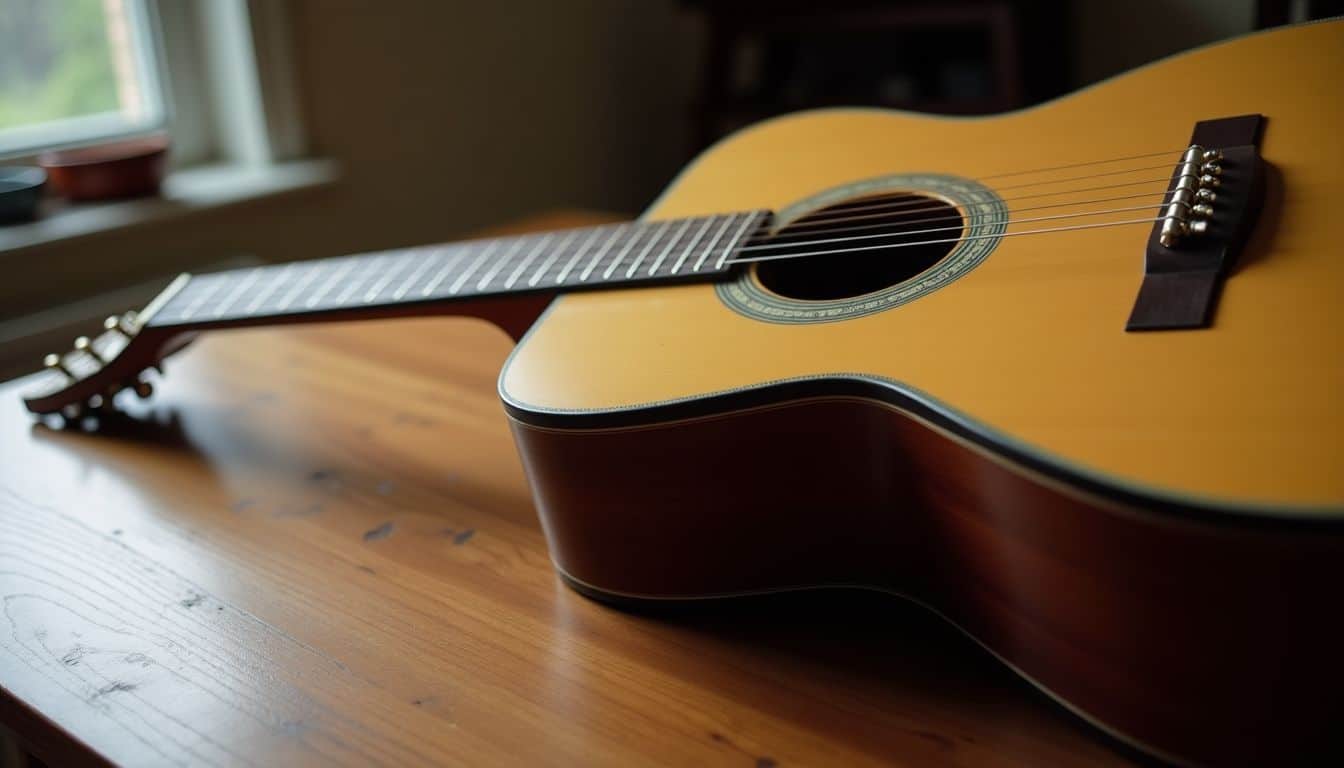
Getting to know your guitar starts with its basic parts. The headstock sits at the top, holding six tuning pegs that control string tension. Moving down, the neck features metal frets and a fingerboard where your fingers press the strings.
The body houses vital parts like the bridge, pickups (on electric guitars), and sound hole (on acoustic guitars).
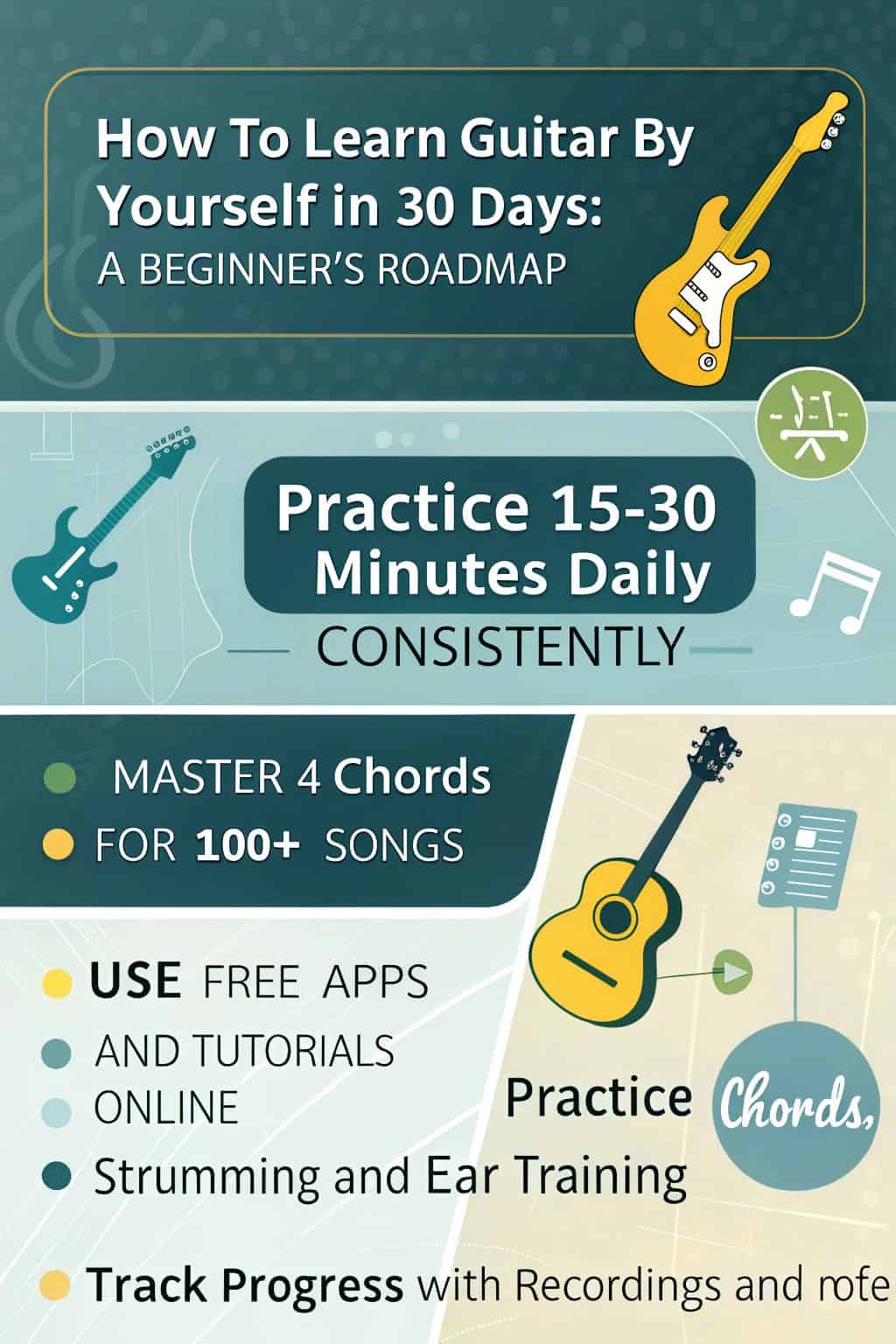
The strings run from the headstock to the bridge, creating different notes as you play them. Each string has a name and number – starting from the thinnest (first string) to the thickest (sixth string).
Learning bass tabs works better after understanding these string names: E (first), B (second), G (third), D (fourth), A (fifth), and E (sixth). A helpful way to learn this is using “Every Boy Gets Dinner At Eight” to recall the string order.
Practice holding and tuning the guitar
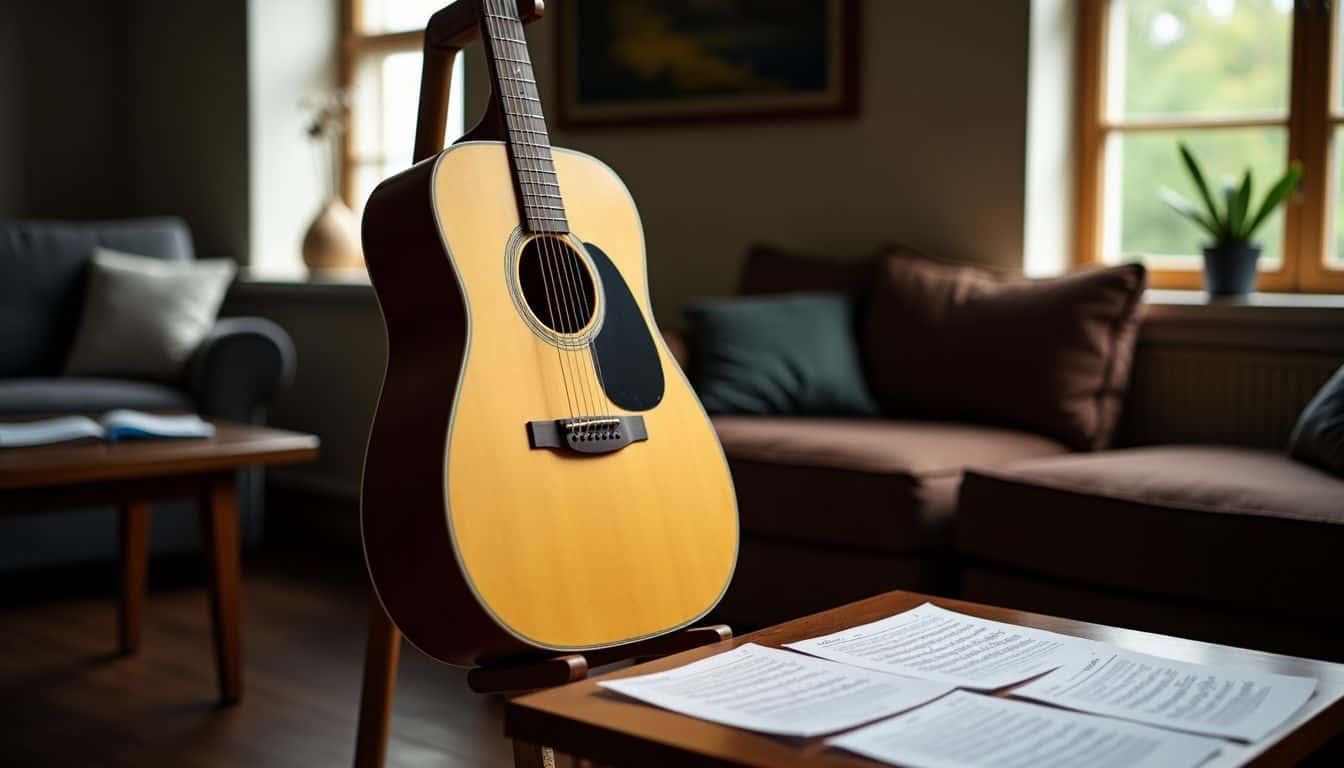
Your guitar needs to sit comfortably on your lap. Place your strumming arm over the body, and rest your fretting hand under the neck. The guitar neck should point slightly upward, not parallel to the ground.
Your back must stay straight while you play. A proper posture prevents strain and helps you play longer.
A well-tuned guitar is half the battle won.
Tuning your guitar is a vital first step before each practice. The six strings must match these notes: E, A, D, G, B, and E (from thickest to thinnest). A guitar tuner app on your phone is free and works great for beginners.
Train your ear to recognize these root notes as you tune. Many new players rush past this step, but proper tuning affects how well you’ll learn chords later. The fretboard becomes essential as you progress to learning basic chords.
Consider which guitar type fits you best.
Choose the Right Guitar

Picking your first guitar will shape your entire learning path. A good starter guitar feels smooth under your fingers and matches your music style, whether you want to strum campfire songs or rock out in your bedroom.
Acoustic vs. electric guitars
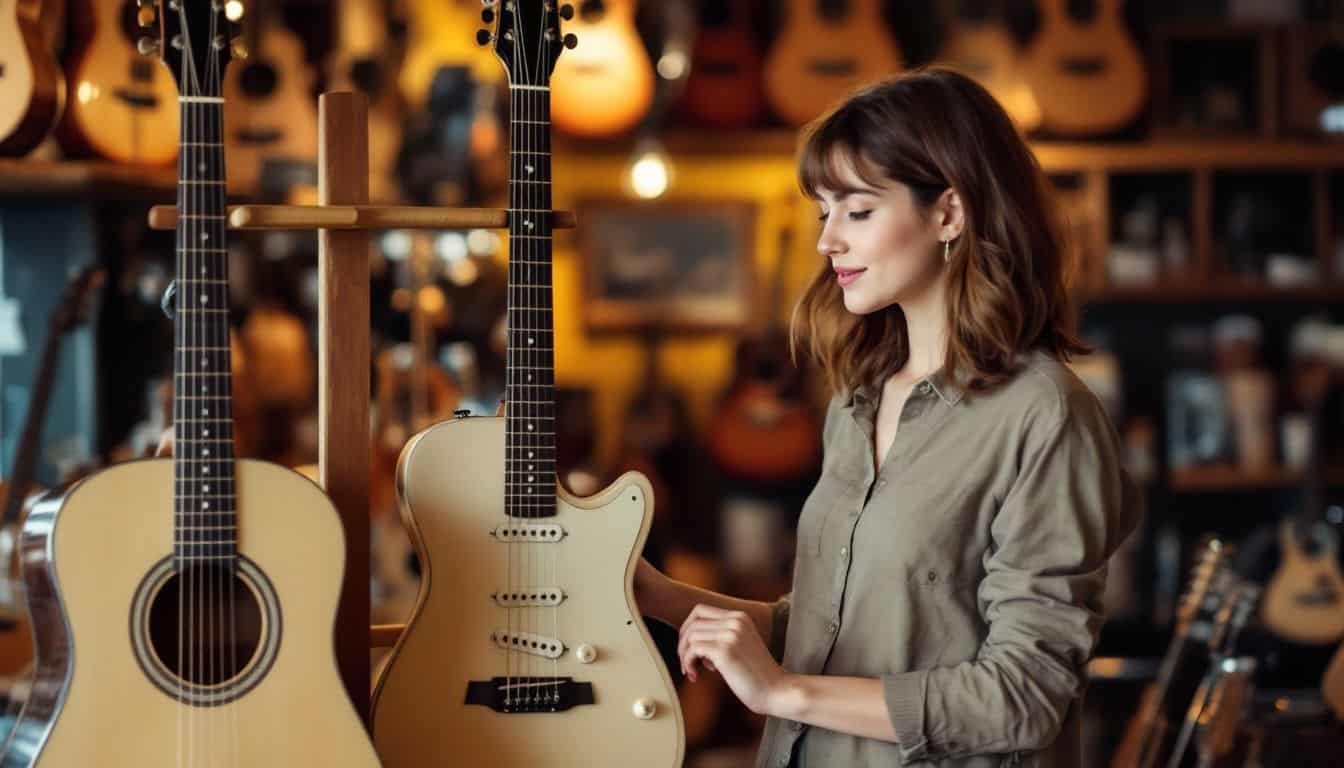
Choosing between acoustic and electric guitars marks a crucial first step in your musical path. Both options offer distinct advantages for aspiring guitarists interested in learning an instrument. Let’s break down their key differences in an easy-to-digest format.
| Feature | Acoustic Guitar | Electric Guitar |
|---|---|---|
| String Type | Thicker strings, harder on fingers initially | Thinner strings (.009-.042), easier on beginners’ fingers |
| Equipment Needed | Just the guitar | Guitar, amp, cables, power source |
| Cost | Lower initial investment | Higher startup costs with accessories |
| Portability | Play anywhere | Needs power source and amp |
| Sound Volume | Natural projection | Adjustable through amp |
| Maintenance | Minimal upkeep | Regular electronics check needed |
| Popularity | Most popular among beginners | Popular for specific genres |
| Practice Flexibility | Can practice anywhere | Needs setup time |
My first guitar was acoustic, and I loved its simplicity. Many women prefer starting with acoustics due to their straightforward nature and lower maintenance needs. Electric guitars shine in rock and metal genres, while acoustics excel in folk, country, and singer-songwriter styles.
Budget-friendly options for beginners

You don’t need to spend big bucks to start playing guitar. Local libraries often loan out guitars for free, making them perfect for testing the waters. I started with a borrowed guitar from my cousin, and it served me well for months.
Many music stores also offer rent-to-own options that won’t break the bank.
Orangewood guitars give you great value for your money. Their Austen and Oliver models cost less than fancy dinner dates but deliver solid sound quality. The classical guitar style works great for learning basic chords and strumming patterns.
These guitars come with steel strings that last long and produce clear tones. Plus, they’re built tough enough to handle daily practice sessions without falling apart.
Learn Basic Chords and Strumming

Learning basic chords and strumming patterns forms the backbone of your guitar skills. Your fingers might feel stiff at first, but with daily practice, you’ll master the four basic chords that open up hundreds of popular songs.
Master four essential chords
Four basic guitar chords will open up a world of music for you. E minor, G major, C major, and D major form the backbone of countless popular songs. I started with these exact chords five years ago, and they still serve me well today.
These chords work great for rhythm guitar parts and let you play dozens of famous tunes right away.
Guitar teacher Marty Schwartz shows how these four chords create magic in 22 different songs. The beauty lies in their simple finger positions – you’ll master them faster than you think.
Place your fingers on the right frets, strum with a guitar pick, and you’re making music. Your fingertips might feel sore at first, but stick with it. Soon your muscle memory will take over, and these chord shapes will feel natural as breathing.
Practice simple strumming patterns
Now that you’ve got those basic chords down, let’s get your strumming hand moving. I started with two simple patterns that made a huge difference in my playing. The first pattern uses downstrums on each beat – just count “1-2-3-4” and strum down.
Your plectrum should hit the strings in a smooth motion.
Rhythm is the soul of music, and strumming is your heartbeat on the guitar.
The next pattern adds upstrums between beats, creating a bouncy feel. Think “down-up-down-up” as your hand moves. I teach my students to practice these patterns slowly at first. Start at 60 beats per minute on your metronome.
Your dexterity will build up naturally as you play along with simple songs. Many lead guitarists started with these exact patterns before moving to complex rhythms.
Use Online Resources
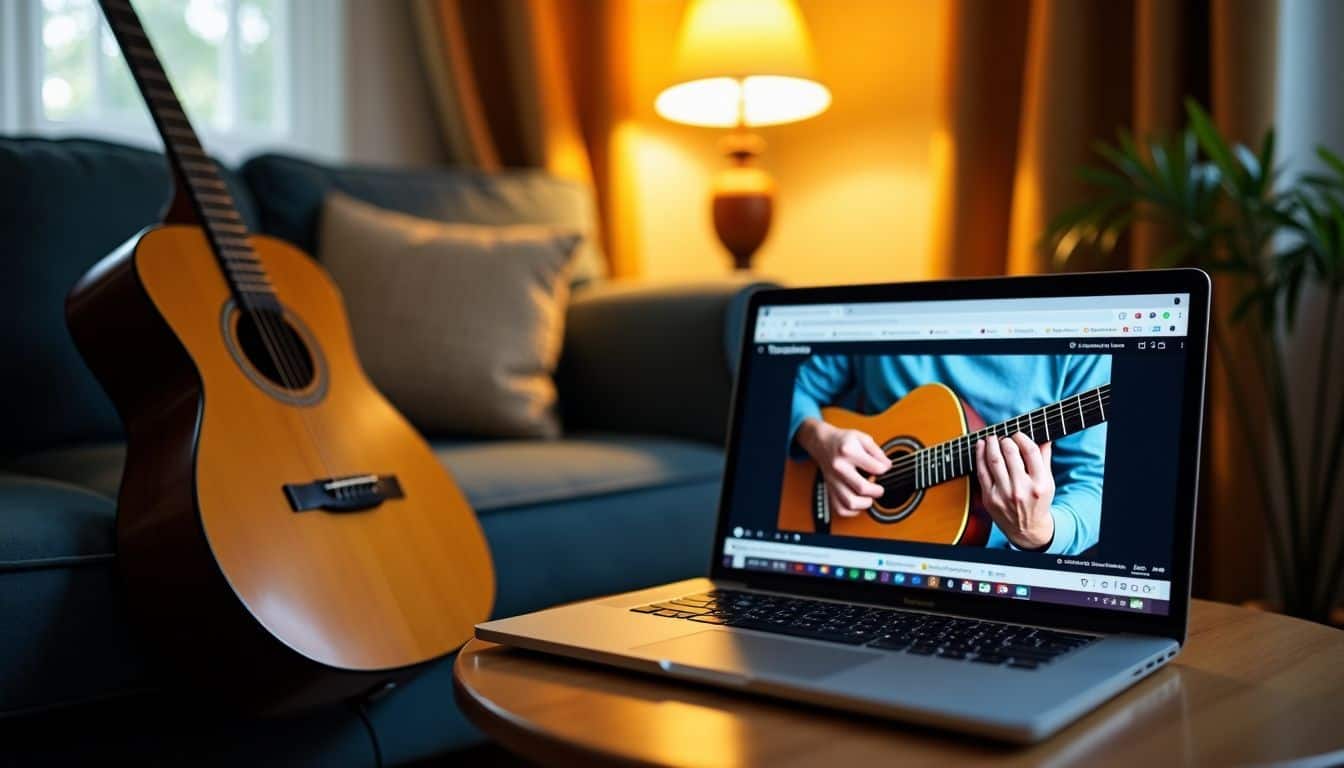
The internet brims with free guitar lessons that match your pace and style. Popular YouTube channels and guitar apps offer step-by-step guidance, from basic chords to advanced techniques.
Best YouTube channels for guitar lessons
YouTube offers amazing free guitar lessons for beginners. JustinGuitar stands out as a top channel, with Justin Sandercoe breaking down complex guitar techniques into bite-sized lessons.
His clear teaching style makes learning scales and basic rhythm guitarist skills feel less scary. Lauren Bateman’s channel focuses on teaching four key chords that will get you playing songs fast.
Free guitar channels give you flexible learning options right at home. You can pause, rewind, and practice at your own speed while learning tablature and proper string techniques. Many channels offer structured lessons from basic to advanced skills, perfect for fitting practice into your busy schedule.
Now, let’s check out some helpful guitar learning apps that can boost your progress.
Recommended guitar learning apps
Guitar learning apps make practice fun and easy. I tested several apps last month, and Yousician stands out as a top pick. This app turns guitar practice into an exciting game, helping you master chords and timing.
The app watches you play and gives instant feedback on your progress. JustinGuitar offers free step-by-step lessons that break down complex skills into bite-sized pieces. According to Adam at men’s lifestyle website unfinished man, these apps can speed up your learning curve by 40%.
Both apps help train your ear and build solid music theory basics. They teach you to read guitar tabs and spot chord changes by sound. The best part? You can practice at your own speed without feeling rushed.
These apps work great for learning songs by ear, which helps you grow as a guitarist and vocalist. Now, let’s look at how to put these skills to work by playing actual songs.
Practice By Playing Songs

Playing songs brings your guitar skills to life. Pick a tune with three or four basic chords, like “Sweet Home Alabama” or “Horse With No Name,” and you’ll build muscle memory while having fun with your pentatonic scales.
Pick songs with simple chord progressions
Starting with easy songs builds your confidence fast. “Stand By Me” by Ben E. King uses just four basic chords – G, Em, C, and D. These guitartricks make learning smoother because you’ll practice the same patterns over and over.
Your fingers will start to move without much thinking, just like typing on a keyboard.
Music is the space between the notes – Claude Debussy
Simple songs give you room to focus on your guitar string movements and timing. Most pop and folk tunes stick to these four chords in different orders. This pattern helps you master the basics before jumping into complex stuff.
Your brain needs time to create muscle memory, so stick with these basic progressions for at least two weeks. Try recording yourself on your phone to spot areas that need work.
Play along with recordings to improve timing
Playing with recordings helps you become a better guitarist. I grab my guitar each morning and strum along to my favorite pop songs. The music acts as my personal beat keeper, showing me the right pace and rhythm.
The steady beat from recordings teaches my hands and ears to work as a team.
Singing the notes while playing makes a huge difference in timing. My students love this trick because it connects their voice to their fingers. Pop and folk songs work great for this method.
The simple chord changes in these songs let you focus on staying in time with the music. Your brain picks up the natural flow of the song, making your playing smoother and more musical.
Train Your Ear

Training your ear helps you spot chords in songs without looking them up. You’ll grow faster as a beginner guitarist when you practice matching sounds to finger positions on your fretboard.
Learn to identify chords by sound
Your ears will spot the bass note first – that’s your starting point for chord recognition. I learned this trick during my early guitar days, and it makes a huge difference. The bass note gives you a solid base to figure out the rest of the chord.
Next, pay attention to how the notes blend together. Major chords sound bright and happy, while minor chords have a darker, moodier feel.
Most beginner guitarists start by learning the basic major and minor chords by ear. The secret lies in the space between notes – we call this dissonance. Listen closely to how the notes work together.
The more you practice, the faster you’ll pick up these subtle differences. I suggest playing each chord slowly, one note at a time. This helps train your brain to catch those tiny details that make each chord special.
Practice playing songs by ear
Once you can spot chords by sound, start playing simple songs by ear. Pick a melody you love and try to match the notes on your guitar. Start with basic tunes like “Happy Birthday” or “Twinkle, Twinkle Little Star.” Record yourself humming or singing the melody first.
This gives you a clear target to aim for on your guitar.
Play along with your recorded voice to match the notes. Start slow and break the song into small chunks. Focus on one part at a time until you nail it. Many guitar players find this method helps them learn faster than reading sheet music.
Soon you’ll catch yourself picking up tunes from the radio and playing them on your guitar without any help.
Explore Music Theory Basics
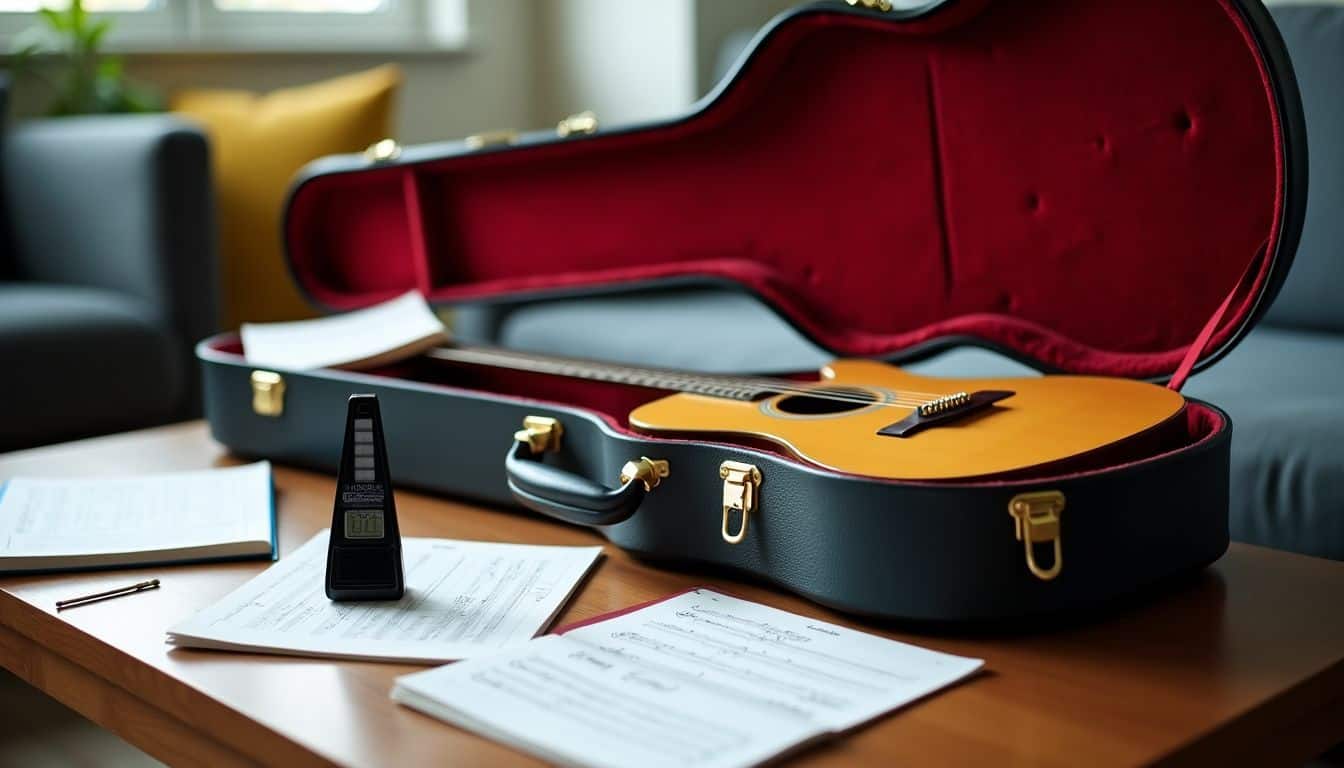
Music theory opens up a whole new world of guitar playing. You’ll grasp the building blocks of music, like scales and chord patterns, which will make your practice sessions more fun and productive.
Understand scales and chord structures
Scales and chords form the building blocks of guitar playing. The major scale follows a simple pattern of whole steps and half steps between notes. Think of it like climbing stairs – some steps are bigger than others.
You’ll spot this pattern on your guitar neck through the Major Scale Guitar Map, which shows you where to place your fingers.
Chord structures grow from these scales, just like branches from a tree. Each chord has a root note that gives it its name, plus other notes that create its special sound. Start with basic open chords – they need just three fingers on specific frets.
These chords will pop up in most songs you’ll want to play. Your fingers might feel stiff at first, but they’ll get stronger with daily practice.
Learn to read guitar tabs
Guitar tabs offer a simple way to learn songs without reading music notes. Think of tabs as a map of your guitar strings – six lines show you exactly where to place your fingers. The top line matches your thinnest string, while the bottom line shows your thickest string.
Numbers on the lines tell you which fret to press, and a “0” means you play the string without pressing any frets.
Reading tabs feels like following a recipe. Each line gives you clear steps to play the right notes at the right time. Start slow and focus on one string at a time. Many free tab websites exist online, making it easy to find songs you love.
Pick easy songs first, and you’ll build confidence fast.
Stay Consistent and Patient

Learning guitar takes time and grit, just like building any new skill. You’ll need to carve out 30 minutes each day for practice, and stick to it like glue, even on days when you’d rather watch TV.
Set a daily practice schedule
Your guitar practice needs a fixed spot in your daily routine, just like brushing your teeth or having breakfast. Pick a time slot that fits your schedule – maybe right after work or first thing in the morning.
Stick to at least 15 minutes of practice each day. I found that splitting my practice into two parts works best: half for learning new skills and half for playing around with what I already know.
Make your practice space cozy and free from distractions. Keep your guitar visible and within reach – this makes it harder to skip practice days. Put a small timer nearby to track your sessions.
Your phone works great for this, but keep it on silent mode. Many of my students who followed this simple setup saw big improvements in just a few weeks. The key is showing up every day, even if you don’t feel like it.
Track your progress over time
Recording your practice sessions significantly improves your guitar skills. Use your phone to film yourself playing that new chord progression or strumming pattern. Next week, record the same piece again.
You’ll spot the small wins and areas that need work. This straightforward technique helps you develop as a guitarist.
Progress happens in tiny steps, not giant leaps. Use a practice diary to note what you learned each day. Mark down the minutes you practiced and which songs you worked on. Many students find that tracking their practice time motivates them to continue practicing.
The evidence shows in your recordings – those awkward first attempts turn into smooth playing over time.
People Also Ask
Can I really learn guitar in just 30 days?
Yes, you can learn basic guitar skills in 30 days. You’ll master simple chords, easy strumming patterns, and a few beginner songs. Just practice 30 minutes daily, and stick to a solid plan.
What gear do I need to start learning guitar?
You’ll need a starter acoustic or electric guitar, a tuner, some picks, and maybe a capo. Don’t break the bank! A basic setup works fine for beginners. Add a metronome app on your phone too.
Should I learn on acoustic or electric guitar first?
Both work well for beginners. Acoustic guitars are cheaper and portable. Electric guitars can be easier on your fingers but need more gear. Pick what matches the music you love most.
How do I avoid common beginner mistakes?
Start slow and focus on proper form. Keep your nails short, use your fingertips to press strings, and don’t skip the basics. Many newbies rush into hard songs too fast. Take baby steps, and your fingers will thank you later.
References
https://guitargetlessons.com/beginners-roadmap/
https://www.pickupmusic.com/blog/how-to-learn-guitar-by-yourself
https://hubguitar.com/articles/acoustic-or-electric
https://learn.truefire.com/acoustic-vs-electric-guitar-which-to-choose-first
https://chambersmusicstudio.com/how-to-learn-guitar/ (2023-12-29)
https://goodguitarist.com/master-the-four-simple-chords-of-stand-by-me/
https://www.stringkick.com/blog-lessons/strumming-patterns/
https://blog.guitaristnextdoor.com/best-youtube-channels-for-free-guitar-lessons/ (2024-12-23)
https://gretsch-talk.com/threads/best-app-for-learning-guitar.224723/ (2024-01-28)
https://appliedguitartheory.com/lessons/easy-songs-for-guitar/
https://www.youtube.com/watch?v=xK89vROE1R0
https://www.stringkick.com/blog-lessons/play-guitar-by-ear/
https://www.soundguitarlessons.com/blog/46
https://www.schoolofrock.com/resources/guitar/reading-guitar-tabs-for-beginners
https://www.playguitaracademy.com/blog/guitar-practice-schedule-090
